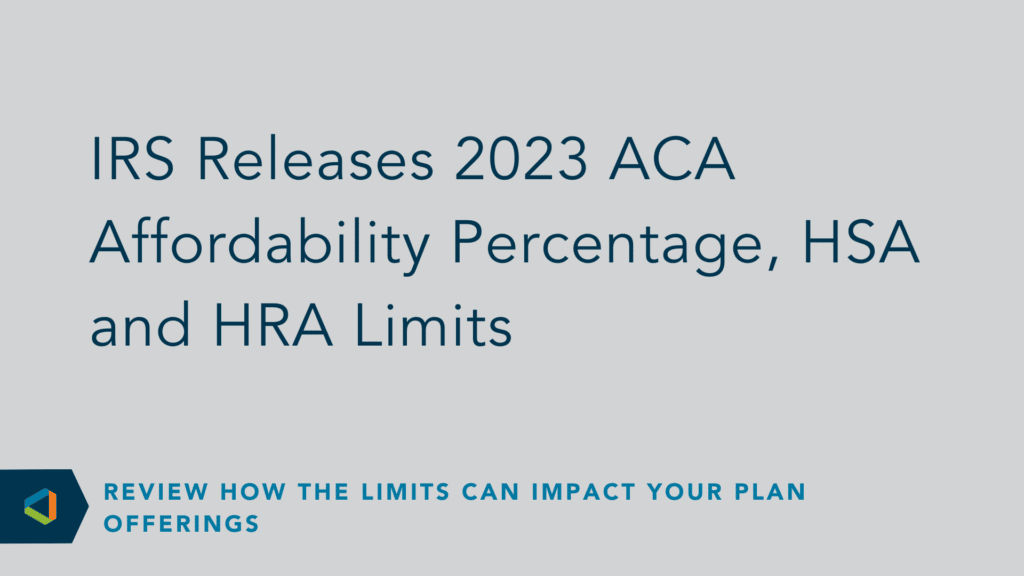Better Benefits, No Headaches
Health Savings Accounts (HSAs): Frequently Asked Questions by Employees
Health Savings Accounts (HSAs): Frequently Asked Questions by Employees
A Health Savings Account (HSA) is an account that allows you to set aside money for your future medical expenses when you are enrolled in a qualified high deductible health plan (HDHP).
1. What is a qualified high deductible health plan (HDHP)?
An HSA provides tax advantages to you, while you make decisions on how to spend your health care dollars.
There are several key provisions for a health plan to be a qualified HDHP:
- The plan must have a minimum deductible set by the IRS and indexed annually.
- The majority of expenses, including prescription drugs, must be subject to the deductible.
- Preventive services, such as well-child care and routine cancer screenings, are the only benefit not subject to the deductible.
- If you are enrolled in family coverage, the minimum family deductible may need to be met before any expenses are paid by the plan, even if only one family member has expenses.
2. Who is eligible to contribute to an HSA?
You must be enrolled in a qualified high deductible health plan (HDHP) to contribute to an HSA.
However, you cannot contribute towards an HSA if you are enrolled in any other non-HDHP health coverage, including a general-purpose health care flexible spending account (FSA), your spouse’s employer’s non-HDHP health coverage, Medicare, Medicaid, or TRICARE.
Other non-HDHP coverage includes health care FSA coverage that your spouse may have at his/her employer. Unless the health care FSA is HSA-compatible (limited-purpose or post-deductible only), you need to be excluded from all health care FSA coverage to contribute to your HSA.
If you enroll in Medicare, including just Part A, your annual contribution limit will be reduced by the months you are enrolled in Medicare. Be aware that when you enroll in Part A after age 65, it goes into effect retroactively for up to 6 months (but not before your 65th birthday month). When you apply for Social Security benefits, enrollment in Medicare Part A is automatic if you are at least age 65, and the effective date may be retroactive.
When you enroll in Medicare during the year, you should ensure that your contributions do not exceed the annual limit, reduced by the months you had Medicare, including any months that Part A is in effect retroactively.
You may still contribute to your HSA, up to the IRS family limit, if your covered family members have other non-HDHP coverage. For example, your spouse may be enrolled in your employer plan and Medicare Part A. Since your spouse is not the HSA account holder, you can still contribute up to the family HDHP limit.
Learn how to Maximize Your HSA by watching a webinar on-demand from OneDigital's Financial Academy.
3. What are the tax advantages of an HSA?
In general, your contributions and any employer contributions are not treated as taxable income to you if you were enrolled in a qualified HDHP at the time contributions were made and were not enrolled in other non-HDHP health coverage. Any investment earnings on funds in your HSA grow tax-free.
You do not pay taxes on distributions from your HSA when used for qualified medical expenses. However, if you use the HSA for nonqualified medical expenses, the distribution is taxable, plus a 20% penalty. (If you are 65 years or older, the 20% penalty is waived for nonqualified medical expenses).
4. What are the IRS contribution limits?
- For 2023, the annual contribution limits are $3,850 ($320.83 per month) for single HDHP coverage and $7,750 ($645.83 per month) for family HDHP coverage.
- For 2024, the annual contribution limits are $4,150 ($345.83 per month) for single HDHP coverage and $8,300 ($691.67 per month) for family HDHP coverage.
- If you are age 55 or older, you can make a $1,000 annual ($83.33 per month) catch-up contribution in addition to the above limits. Only the HSA accountholder can make a catch-up contribution.
5. How do I make contributions into my HSA?
Your employer may allow you to make pre-tax contributions through payroll. Also, you can make contributions directly to your HSA and deduct the contribution, up to IRS limits, on your federal income tax return.
You can only make tax-free contributions to an HSA for each month that you are enrolled in a qualified high deductible health plan (HDHP) and are not enrolled in any other non-HDHP health plan. You must be enrolled in a qualified HDHP on the first day of the month to make an HSA contribution for that month. If your coverage in a qualified HDHP begins in the middle of the month, you can start making HSA contributions on the first day of the following month.
Your spouse and children can be covered by both your HDHP and another non-HDHP health plan.
Your employer may also make contributions to your HSA to help you offset the expense of the high medical plan deductible.
6. How are my HSA funds invested?
Your HSA deposits are initially deposited into a checking account. Once your HSA account balance reaches a certain minimum amount, you may be able to transfer a portion of your balance to an HSA investment account. Contact your HSA vendor to learn more about investment options for your HSA funds.
7. How do I use the funds in my HSA?
You can use your HSA to reimburse yourself for qualified out-of-pocket medical expenses incurred by you, your spouse (but not your domestic partner), and tax dependents, even if they are not enrolled in the HDHP. A tax dependent is a dependent who is not yet 19 (or, if a student, not yet 24) by the end of the tax year or who is permanently and totally disabled at any age.
You will receive a debit card that you can use at certain medical providers and pharmacies. The debit card will automatically withdraw money from your HSA to pay for a qualified medical out-of-pocket expense. You can also use your online HSA account to pay providers or reimburse yourself.
You do not file claim forms or receipts to get funds from your HSA. You are responsible for getting receipts for medical care and keeping proof of medical expenses on file for the IRS.
8. How are qualified medical expenses?
You can spend HSA dollars on any “qualified medical expense” allowed by federal tax law, which includes expenses applied towards your deductible, copays and coinsurance, as well as dental and vision expenses. Please see IRS Publication 502 for a detailed list of eligible expenses.
Health insurance premiums are not eligible expenses unless the premiums are post-tax payments for:
- long term care insurance
- COBRA coverage
- retiree health plan and Medicare premiums (but not Medigap) if the HSA accountholder is age 65+
- health care coverage while you are receiving unemployment benefits.
Additionally, in July of 2019, the IRS expanded the list of preventive care benefits to include care for certain chronic conditions, including asthma, congestive heart failure, depression, diabetes, heart disease, hypertension, and osteoporosis. For the complete list of preventive care services for chronic conditions that are now eligible to be paid for with HSA dollars, see IRS Notice 2019-45.
9. When can I begin contributing to my account, and when can I begin withdrawing funds?
You can start making HSA contributions and, in turn, taking distributions for eligible expenses only after your HSA bank account has actually been established. Under state trust law, there are typically three elements that must be present in order for the HSA to be considered open:
- Intent to establish the account
- Cash funds
- Designation of a beneficiary
In many cases, this will occur after you first enroll in the HDHP.
For example, consider the following scenario:
- You enroll in the HDHP in November for a January 1 effective date.
- You complete and sign the HSA paperwork on January 13 and submit it electronically on January 15.
- The bank receives your paperwork on January 20.
- An account is created and a number is assigned on January 23.
- The first HSA deposit is made via payroll on February 1.
- You may begin taking distributions for eligible expenses incurred on or after February 1.
We encourage you to open your HSA as soon as possible to avoid delayed expense eligibility or missed contributions.
10. What if I have an out-of-pocket medical expense that is more than my HSA account balance?
You can only use what is in your HSA account balance. You must pay out-of-pocket for any expense that exceeds your HSA balance and can reimburse yourself as HSA funds are replenished.
11. What happens to my HSA if I lose eligibility for the HDHP, enroll in non-HDHP coverage, or terminate employment mid-year?
The HSA is in your name and you remain the owner of the account. If you lose eligibility or terminate employment, you do not forfeit any balance in the account, and you can continue to use the funds in your account for eligible medical expenses.
However, you can no longer contribute to the HSA unless you remain covered by a HDHP (either through COBRA or through another qualified HDHP). Also, you will be responsible for any future account fees that were previously paid by your employer.
There is potential taxation of HSA contributions if you terminate HDHP coverage before the end of the calendar year and your HSA contributions exceed the pro-rated IRS annual maximum. For example, say you have single coverage, you and/or the employer contributed $2,000 to your HSA on January 1, and you only remain covered for the next 3 months. In 2023, only $962.49 ($320.83 x 3) is tax-free for 3 months of single HDHP coverage. You would be responsible for income taxes on the excess contribution of $1,037.51 ($2,000-$962.49). There is also a 6% excise tax on excess contributions and income that are not timely withdrawn.
12. If I enroll in the HDHP mid-year, how much can I contribute to my HSA?
If you are eligible and enroll in the HDHP during the calendar year, you can open an HSA at that time. You can contribute up to the monthly IRS limit for each month you have HDHP coverage.
If you contribute more than the monthly IRS limit for each month you have HDHP coverage, you may owe taxes and a penalty on the contributions allocated to the months prior to your HDHP enrollment -- unless you are enrolled on December 1 and continue HDHP coverage through the end of the following calendar year. The IRS refers to this as the “last-month rule” and provides a detailed explanation in Publication 969.
If you enroll mid-year, remember you cannot be covered by any other non-HDHP plan if you wish to make contributions to your HSA, which includes coverage through your or your spouse’s health care FSA which cannot be terminated mid-year.
13. Can I open and contribute to an HSA if my spouse also has an HSA?
Yes, both spouses are free to open and contribute to their own respective HSA account if both spouses have HDHP coverage and no disqualifying coverage. Under a special rule for married individuals, if either spouse is enrolled in family coverage, then both spouses are treated as being enrolled in family coverage. This rule holds true even if the family coverage only covers the employee and dependents and not the other spouse. The maximum joint contribution for two married, HSA-eligible individuals is the annual family contribution maximum.
14. What are my tax reporting requirements?
Your employer will report your pre-tax contributions and any employer contributions in Box 12 on your Form W-2.
The trustee of your HSA will send you a Form 1099 for any distributions and Form 5498 for any contributions.
When you file your federal income tax return, you must complete and attach Form 8889, “Health Savings Accounts”.
15. Where can I get additional information?
Please contact your employer or the trustee or bank responsible for your HSA account if you have additional questions. You may also refer to IRS Publication 502 (Medical and Dental Expenses) and IRS Publication 969 (Health Savings Accounts & Other Tax-Favored Health Plans).
Looking for more ways to maximize your employee benefits? Visit The Breakroom for resources that answer more FAQs.




